

Standard Model. Elementary Particles Diagram. Quantum mechanics. Wavefunctions of the electron in a hydrogen atom at different energy levels.
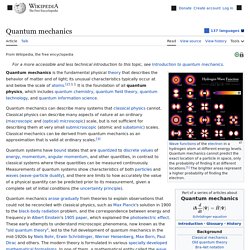
Quantum mechanics cannot predict the exact location of a particle in space, only the probability of finding it at different locations.[1] The brighter areas represent a higher probability of finding the electron. Quantum mechanics (QM; also known as quantum physics, quantum theory, the wave mechanical model, or matrix mechanics), including quantum field theory, is a fundamental theory in physics which describes nature at the smallest scales of atoms and subatomic particles.[2] Quantum mechanics gradually arose from theories to explain observations which could not be reconciled with classical physics, such as Max Planck's solution in 1900 to the black-body radiation problem, and from the correspondence between energy and frequency in Albert Einstein's 1905 paper which explained the photoelectric effect.
Atom. The atom is a basic unit of matter that consists of a dense central nucleus surrounded by a cloud of negatively charged electrons.
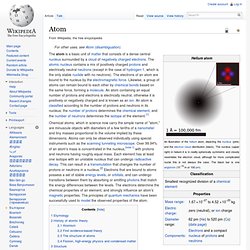
The atomic nucleus contains a mix of positively charged protons and electrically neutral neutrons (except in the case of hydrogen-1, which is the only stable nuclide with no neutrons). The electrons of an atom are bound to the nucleus by the electromagnetic force. Likewise, a group of atoms can remain bound to each other by chemical bonds based on the same force, forming a molecule. An atom containing an equal number of protons and electrons is electrically neutral, otherwise it is positively or negatively charged and is known as an ion.
Subatomic particle. In the physical sciences, subatomic particles are particles smaller than atoms.[1] (although some subatomic particles have mass greater than some atoms).
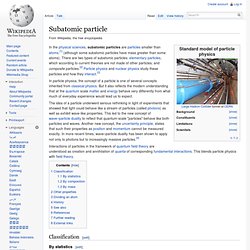
List of particles. Atomic nucleus. A model of the atomic nucleus showing it as a compact bundle of the two types of nucleons: protons (red) and neutrons (blue).

In this diagram, protons and neutrons look like little balls stuck together, but an actual nucleus (as understood by modern nuclear physics) cannot be explained like this, but only by using quantum mechanics. In a nucleus which occupies a certain energy level (for example, the ground state), each nucleon has multiple locations at once. The nucleus is the very dense region consisting of protons and neutrons at the center of an atom. It was discovered in 1911 as a result of Ernest Rutherford's interpretation of the 1909 Geiger–Marsden gold foil experiment performed by Hans Geiger and Ernest Marsden under Rutherford's direction.
Proton. Electron. History[edit] In the early 1700s, Francis Hauksbee and French chemist Charles François de Fay independently discovered what they believed were two kinds of frictional electricity—one generated from rubbing glass, the other from rubbing resin.

From this, Du Fay theorized that electricity consists of two electrical fluids, vitreous and resinous, that are separated by friction, and that neutralize each other when combined.[17] A decade later Benjamin Franklin proposed that electricity was not from different types of electrical fluid, but the same electrical fluid under different pressures. He gave them the modern charge nomenclature of positive and negative respectively.[18] Franklin thought of the charge carrier as being positive, but he did not correctly identify which situation was a surplus of the charge carrier, and which situation was a deficit.[19] Discovery[edit]
Neutron. The neutron is a subatomic hadron particle that has the symbol n or n0.

Neutrons have no net electric charge and a mass slightly larger than that of a proton. With the exception of hydrogen-1, the nucleus of every atom consists of at least one or more of both protons and neutrons. Protons and neutrons are collectively referred to as "nucleons". Since interacting protons have a mutual electromagnetic repulsion that is stronger than their attractive nuclear interaction, neutrons are often a necessary constituent within the atomic nucleus that allows a collection of protons to stay atomically bound (see diproton & neutron-proton ratio).[4] Neutrons bind with protons and one another in the nucleus via the nuclear force, effectively stabilizing it. Fermion. Antisymmetric wavefunction for a (fermionic) 2-particle state in an infinite square well potential.

In particle physics, a fermion is a particle that follows Fermi–Dirac statistics. These particles obey the Pauli exclusion principle. Fermions include all quarks and leptons, as well as all composite particles made of an odd number of these, such as all baryons and many atoms and nuclei. Fermions differ from bosons, which obey Bose–Einstein statistics. In addition to the spin characteristic, fermions have another specific property: they possess conserved baryon or lepton quantum numbers. Lepton. A lepton is an elementary, spin-1⁄2 particle that does not undergo strong interactions, but is subject to the Pauli exclusion principle.[1] The best known of all leptons is the electron, which governs nearly all of chemistry as it is found in atoms and is directly tied to all chemical properties.
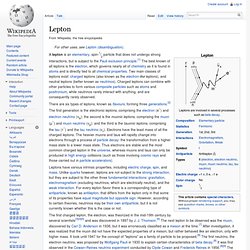
Two main classes of leptons exist: charged leptons (also known as the electron-like leptons), and neutral leptons (better known as neutrinos). Charged leptons can combine with other particles to form various composite particles such as atoms and positronium, while neutrinos rarely interact with anything, and are consequently rarely observed. The first charged lepton, the electron, was theorized in the mid-19th century by several scientists[3][4][5] and was discovered in 1897 by J. J. Thomson.[6] The next lepton to be observed was the muon, discovered by Carl D. Quark. A quark (/ˈkwɔrk/ or /ˈkwɑrk/) is an elementary particle and a fundamental constituent of matter.

Quarks combine to form composite particles called hadrons, the most stable of which are protons and neutrons, the components of atomic nuclei.[1] Due to a phenomenon known as color confinement, quarks are never directly observed or found in isolation; they can be found only within hadrons, such as baryons (of which protons and neutrons are examples), and mesons.[2][3] For this reason, much of what is known about quarks has been drawn from observations of the hadrons themselves.
The quark model was independently proposed by physicists Murray Gell-Mann and George Zweig in 1964.[5] Quarks were introduced as parts of an ordering scheme for hadrons, and there was little evidence for their physical existence until deep inelastic scattering experiments at the Stanford Linear Accelerator Center in 1968.[6][7] Accelerator experiments have provided evidence for all six flavors. Strange quark. The strange quark or s quark (from its symbol, s) is the third-lightest of all quarks, a type of elementary particle.
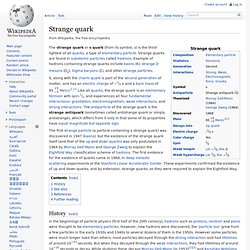
Strange quarks are found in subatomic particles called hadrons. Example of hadrons containing strange quarks include kaons (K), strange D mesons (D s), Sigma baryons (Σ), and other strange particles. History[edit] In the beginnings of particle physics (first half of the 20th century), hadrons such as protons, neutron and pions were thought to be elementary particles. However, new hadrons were discovered, the 'particle zoo' grew from a few particles in the early 1930s and 1940s to several dozens of them in the 1950s. See also[edit] References[edit] Further reading[edit] R. Strangeness. In particle physics, strangeness S is a property of particles, expressed as a quantum number, for describing decay of particles in strong and electromagnetic reactions, which occur in a short period of time.
Hadron. In particle physics, a hadron i/ˈhædrɒn/ (Greek: ἁδρός, hadrós, "stout, thick") is a composite particle made of quarks held together by the strong force (in a similar way as molecules are held together by the electromagnetic force). Of the hadrons, protons are stable, and neutrons bound within atomic nuclei are stable, whereas other hadrons are unstable under ordinary conditions; free neutrons decay with a half life of about 880 seconds. Experimentally, hadron physics is studied by colliding protons or nuclei of heavy elements such as lead, and detecting the debris in the produced particle showers. Etymology[edit] The term "hadron" was introduced by Lev B. Not withstanding the fact that this report deals with weak interactions, we shall frequently have to speak of strongly interacting particles.
Properties[edit] All types of hadrons have zero total color charge. According to the quark model,[5] the properties of hadrons are primarily determined by their so-called valence quarks. Baryon. A baryon is a composite subatomic particle made up of three quarks (as distinct from mesons, which comprise one quark and one antiquark). Baryons and mesons belong to the hadron family, which are the quark-based particles.
The name "baryon" comes from the Greek word for "heavy" (βαρύς, barys), because, at the time of their naming, most known elementary particles had lower masses than the baryons. As quark-based particles, baryons participate in the strong interaction, whereas leptons, which are not quark-based, do not. Meson. In particle physics, mesons (/ˈmiːzɒnz/ or /ˈmɛzɒnz/) are hadronic subatomic particles composed of one quark and one antiquark, bound together by the strong interaction. Sigma baryon. D meson. Charm quark.
Kaon. Basic properties[edit] The four kaons are : The negatively charged K− (containing a strange quark and an up antiquark) has mass 493.667±0.013 MeV and mean lifetime (1.2384±0.0024)×10−8 s.Its antiparticle, the positively charged K+ (containing an up quark and a strange antiquark) must (by CPT invariance) have mass and lifetime equal to that of K−. The mass difference is 0.032±0.090 MeV, consistent with zero. The difference in lifetime is (0.11±0.09)×10−8 s.The K0 (containing a down quark and a strange antiquark) has mass 497.648±0.022 MeV. It has mean squared charge radius of −0.076±0.01 fm2.Its antiparticle K0 (containing a strange quark and a down antiquark) has the same mass. [a] ^ Strong eigenstate. Photon. Gluon. Higgs boson.
The Higgs boson is named after Peter Higgs, one of six physicists who, in 1964, proposed the mechanism that suggested the existence of such a particle. Although Higgs's name has come to be associated with this theory, several researchers between about 1960 and 1972 each independently developed different parts of it. In mainstream media the Higgs boson has often been called the "God particle", from a 1993 book on the topic; the nickname is strongly disliked by many physicists, including Higgs, who regard it as inappropriate sensationalism.[17][18] In 2013 two of the original researchers, Peter Higgs and François Englert, were awarded the Nobel Prize in Physics for their work and prediction[19] (Englert's co-researcher Robert Brout had died in 2011).
A non-technical summary[edit] "Higgs" terminology[edit] Graviton.